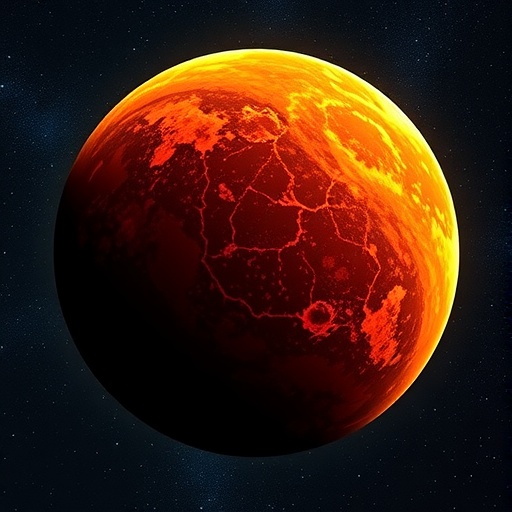A groundbreaking study conducted by scientists at the University of Nevada, Las Vegas (UNLV) has revealed new insights into the complex processes underlying planet formation within our galaxy. By examining the integral role that the life cycles of nearby stars play in this stellar nursery, the research has significant implications for understanding not only the evolution of planetary systems but also the timing of elemental availability crucial for life. This detailed exploration of planetary formation brings forth an exciting perspective on how the materials that constitute planets are synthesized, ultimately shedding light on why the composition and density of rocky planets like Earth can vary so dramatically based on their formation timelines.
The study, prominently featured in the Astrophysical Journal Letters, was led by Jason Steffen, an associate professor of physics and astronomy at UNLV. He, along with his team and collaborators from the Open University of Israel, constructed an innovative model that highlights the linkage between the timing of stellar life cycles and planetary characteristics. The research emphasizes the profound impact of star lifespan on planetary composition, elucidating how the elemental tapestry required for planet formation unfolds over time, rather than appearing all at once.
Central to the findings is the understanding that all the essential building blocks of planets—such as oxygen, silicon, iron, and nickel—originate within stars. When these stars reach the end of their life cycles, the materials they produce are dispersed into the cosmos, forming a fertile ground for new celestial bodies. Notably, high-mass stars tend to die relatively young, usually within a mere 10 million years, but their explosive deaths scatter lighter elements across the surrounding space. These lighter elements are critical for crafting the outer layers of rocky planets.
In contrast, low-mass stars enjoy a prolonged existence that may last billions of years. During their lifetimes, they produce and, upon their eventual demise, release heavier elements, including iron and nickel, which are pivotal for forming planetary cores—a critical aspect of planetary density and composition. The implications of this star-based elemental framework are profound: planets formed in solar systems that have experienced contributions from both high-mass and low-mass stars are more likely to exhibit diverse and complex compositions.
In the study, the researchers revealed that planets emerging from systems dominated by high-mass stars are characterized by larger mantles—a significant attribute as these outer layers often dominate the planetary structure while the cores remain notably smaller. This difference in structure highlights an engaging aspect of planetary evolution, wherein time and the stellar lifecycle contribute to great variances in planetary core size and overall composition.
What is striking is that the research team, over the past decade, had been developing advanced software models for several intricate projects related to astrophysics but had not fully integrated them into a comprehensive model of planet formation until recently. Indeed, the realization that they could attach a small amount of new code to an existing system led to the groundbreaking simulation that effectively traced the entire cycle of planetary evolution from stellar birth through to the formation of planets and their internal structures.
These simulations provide critical insights into how the elements necessary for life, such as carbon and water—integral for biological processes—may not emerge in a singular, rapid burst but instead develop gradually as the galaxy ages. This nuanced understanding posits that the conditions essential for life on Earth may not have been available at the planet’s formation but instead arrived at various stages throughout cosmic history.
The research showcases a pioneering approach to astrobiology, as it bridges the fields of stellar evolution and planetary composition. Furthermore, it invites us to reconsider the timeline of habitability—suggesting that life as we know it would require a more extended period to come into existence than previously surmised. This revelation could have critical implications for the search for extraterrestrial life, as it indicates the need for a more nuanced understanding of when and how life-sustaining elements become available.
In a broader context, this study holds essential implications for our understanding of exoplanets, or planets beyond our solar system, as the findings can be generalized to assess the which exoplanets might hold similar conditions conducive to life. By comprehending how different star lifetimes influence elemental availability and planetary structure, astronomers could optimize their searches for potentially habitable worlds in distant galaxies.
The significance of this research extends beyond academia, igniting the imagination and curiosity of the general public regarding the origins of our own planet and the intricate processes that govern the cosmos. As we continue to explore the universe, studies of this nature emphasize the importance of interdisciplinary collaboration and innovation in unraveling one of humanity’s oldest questions: how did we get here? In this nexus of astronomy and planetary science, the research advances our collective understanding of not only our solar system’s history but also the broader narrative of life in the universe.
Through this research, the scientists at UNLV not only contribute to the scientific community but also engage with the broader public’s fascination with space and our place within it. Their findings open new avenues for exploration and discovery, ensuring that questions about our cosmic origins and the emergence of life will continue to inspire both scientific inquiry and popular imagination.
Subject of Research: Planet Formation and the Role of Star Lifecycles
Article Title: Effect of Galactic Chemical Evolution on Exoplanet Properties
News Publication Date: 23-Sep-2025
Web References: https://iopscience.iop.org/article/10.3847/2041-8213/ae0457
References: DOI: 10.3847/2041-8213/ae0457
Image Credits: Not provided
Keywords
Planet formation, stellar evolution, dense planets, cosmic history, exoplanets, UNLV research, astrobiology, scientific collaboration, elemental composition, life-sustaining materials, astronomical modeling.




